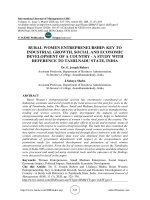Economic growth and economic development 551
Bạn đang xem bản rút gọn của tài liệu. Xem và tải ngay bản đầy đủ của tài liệu tại đây (79.31 KB, 1 trang )
CHAPTER 12
Modeling Technological Change
We have so far investigated models of economic growth of exogenous or endogenous variety. But economic growth has not resulted from technological change.
Either it has been exogenous, or it has been sustained because of a linear neoclassical
technology, or it has taken place as a byproduct of knowledge spillovers. Since our
purpose is to understand the process of economic growth, models in which growth
results from technological progress and technological change itself is a consequence
of purposeful investments by firms and individuals are much more attractive. These
models not only endogenize technological progress, but they also relate the process
of technological change to market structure, anti-trust and competition policy, and
intellectual property rights policy. They will also enable us to discuss issues of directed technical change. In this chapter, we begin with a brief discussion of different
conceptions of technological change and provide some foundations for the models
that will come later.
12.1. Different Conceptions of Technology
12.1.1. Types of Technological Change. The literature on technological
change often distinguishes between different types of innovations. A first useful
distinction is between process and product innovation. While the latter refers to
the introduction of a new product (for example, the introduction of the first DVD
player), the former is concerned with innovations that reduce the costs of production
of existing products (for example, the introduction of new machines to produce existing goods). A third type of innovation is perhaps the most common and involves
the introduction of a higher-quality versions of an existing good. The introduction
of a better DVD player, when there are already DVD players in the market, would
be an example of this third type of innovation. In general, heterogeneous consumers
537









